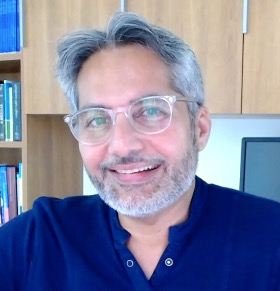From scalar to tensor finite elements

Keywords
Speaker:
Jay Gopalakrishnan
Affiliation:
Portland State University
When:
Thursday 19th September 2024
Time:
14:00:00
Where:
Aula Consiglio VII piano - Dipartimento di Matematica
Abstract:
In the history of finite elements, the earliest Lagrange finite elements, consisted of scalar-valued functions. To approximate fluxes, vector-valued finite elements with continuous normal (n) components across element interfaces, or n-continuous elements, were developed later. The finite element toolkit was then supplemented by t-continuous vector-valued Nedelec elements with continuous tangential (t) components, now routinely used for Maxwell equations. Although these elements were developed separately, today we understand them together as fitting into a cochain subcomplex of a de Rham complex of Sobolev spaces.
Other tensor-valued finite elements are now being viewed with increasing interest and they form the main subject of this talk. The earliest of these consists of matrix-valued functions whose normal-normal (nn) component varies continuously across element interfaces: these are the nn-continuous matrix fields of the Hellan-Herrmann-Johnson element. More recently, nt-continuous matrix-valued finite elements were developed to approximate viscous stress in incompressible flows: they have continuous shear, or normal-tangential (nt) components. To add to this picture, matrix-valued elements with continuous tangential-tangential (tt) components, called Regge elements, are finding increasing utility: they are key to approximating the metric tensor of Riemannian manifolds. This talk delves into the details of these developments.
How does one connect these disparate developments with nn-, nt-, and tt-continuous matrix finite elements? This does not appear to be as easy as the previous synthesis of vector-valued elements by the de Rham complex. The spaces in de Rham complexes are connected by fundamental first-order differential operators (grad, curl, and div in three dimensions), all derived from a single definition of the exterior derivative. In contrast, what is natural for the above-mentioned tensor finite elements are other second-order differential operators. We conclude grazing the frontiers of our understanding on potentially unifying connections.
This initiative is part of the “Ph.D. Lectures” activity of the project "Departments of Excellence 2023-2027" of the Department of Mathematics of Politecnico di Milano. This activity consists of seminars open to Ph.D. students, followed by meetings with the speaker to discuss and go into detail on the topics presented at the talk.
Contatti:
paola.antonietti@polimi.it
gabriele.ciaramella@polimi.it
ilario.mazzieri@polimi.it
Note:
Jay Gopalakrishnan is a computational mathematician whose research centers around improving accuracy and efficiency of finite element methods for partial differential equations. He co-invented two classes of numerical methods, now known as the discontinuous Petrov Galerkin (DPG) methods, and the hybridizable discontinuous Galerkin (HDG) methods. He has co-authored over ninety publications, has served in the editorial boards of seven journals, including service as one of the managing editors. He earned his PhD in 1999 under the supervision of James Bramble and Joseph Pasciak He then worked at Bell Labs, Medtronic Inc, University of Minnesota, and was a mathematics professor at University of Florida for over a decade. He currently holds an endowed chair at Portland State University in Oregon, where he is engaged in a variety of regional activities to bolster scientific computation.
